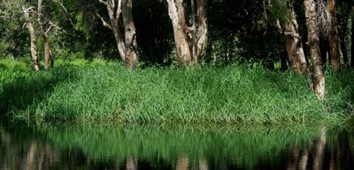What Does It Look Like?
What is it?
Carib Grass (Eriochloa polystachya) is an aquatic, perennial, creeping grass with stems growing to 5–150 cm high with many lateral branches. The stems are cylindrical or slightly compressed, have a central air cavity, and produce roots from their lower nodes. The leaf blade is flat, long and narrow, 6–25 cm long and 6–15 mm wide, with a pointed tip and rough margins.
The inflorescence is formed at the tip of the stem and is 12–24 cm long and branched, with each branch bearing 6–15 tiny flowers (PIER 2008).
For further information and assistance with identification of Carib Grass contact the herbarium in your state or territory.
Flower colour
Unknown
Growth form (weed type/habit)
Grass
Where it currently grows? Preferred habitat
Carib Grass prefers swamps, deep-water rice fields, river banks, drains and ditches on heavy soils. It tolerates strong to medium dry seasons. It is found at the rear of coastal dunes to 500 m altitude (PIER 2008).
Are there similar species?
Carib Grass is one of 30 species in the genus Eriochloa. Keys and descriptions for the native and naturalised Australian species can be found in Sharp & Simon (2002). The use of keys and descriptions for the species occurring in Australia, such as in Sharp & Simon (2002), can provide help in correctly identifying the species.
For further information and assistance with identification of Carib Grass, contact the herbarium in your state or territory.



































